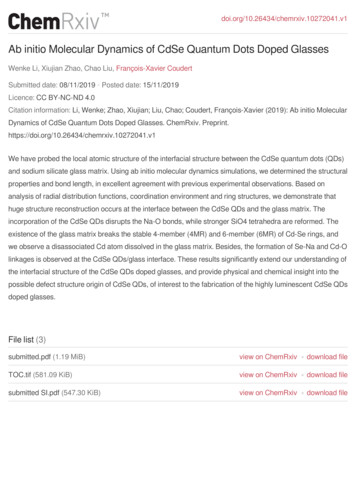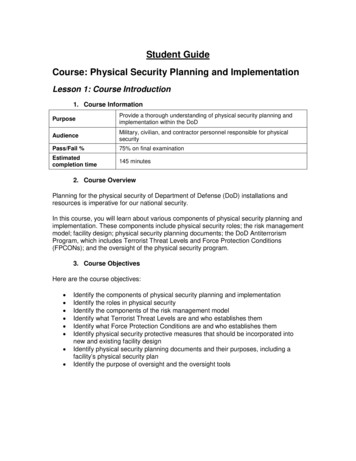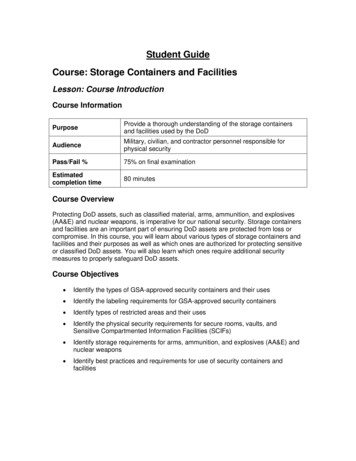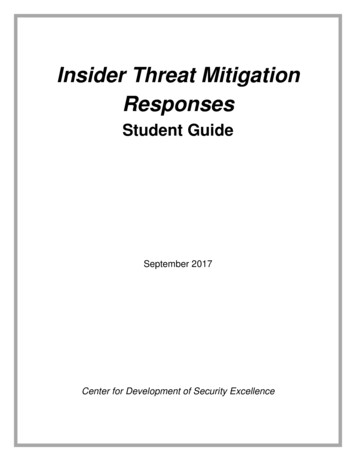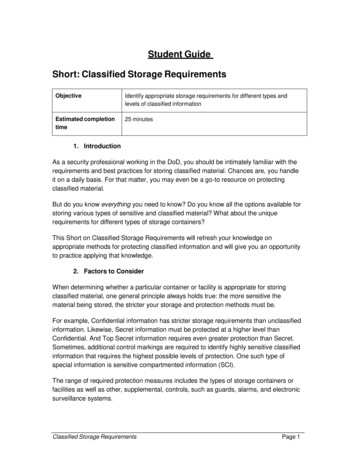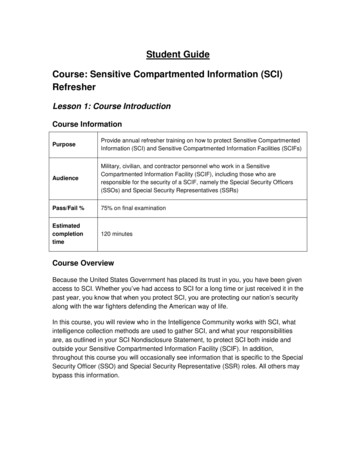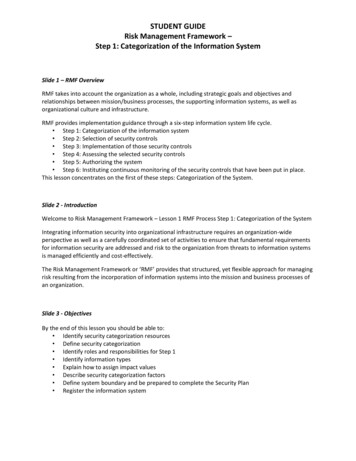
Transcription
STUDENT GUIDERisk Management Framework –Step 1: Categorization of the Information SystemSlide 1 – RMF OverviewRMF takes into account the organization as a whole, including strategic goals and objectives andrelationships between mission/business processes, the supporting information systems, as well asorganizational culture and infrastructure.RMF provides implementation guidance through a six-step information system life cycle. Step 1: Categorization of the information system Step 2: Selection of security controls Step 3: Implementation of those security controls Step 4: Assessing the selected security controls Step 5: Authorizing the system Step 6: Instituting continuous monitoring of the security controls that have been put in place.This lesson concentrates on the first of these steps: Categorization of the System.Slide 2 - IntroductionWelcome to Risk Management Framework – Lesson 1 RMF Process Step 1: Categorization of the SystemIntegrating information security into organizational infrastructure requires an organization-wideperspective as well as a carefully coordinated set of activities to ensure that fundamental requirementsfor information security are addressed and risk to the organization from threats to information systemsis managed efficiently and cost-effectively.The Risk Management Framework or ‘RMF’ provides that structured, yet flexible approach for managingrisk resulting from the incorporation of information systems into the mission and business processes ofan organization.Slide 3 - ObjectivesBy the end of this lesson you should be able to: Identify security categorization resources Define security categorization Identify roles and responsibilities for Step 1 Identify information types Explain how to assign impact values Describe security categorization factors Define system boundary and be prepared to complete the Security Plan Register the information system
STUDENT GUIDERisk Management Framework –Step 1: Categorization of the Information SystemSlide 4 - SourcesThe authoritative sources listed here are to be used for Security Categorization Guidance.CNSSI 1253 establishes guidelines and a method for security categorization for information systems andthe information they contain.NIST SP 800-60 Volume I, dated August 2008, is a best practice guideline to assist in identification ofinformation types.SP800-37 (need description)DoDI8510.01 (need description)RMF Knowledge Service at https://rmfks.osd.mil/rmf is the go to source when working withRMF. (CAC/PKI required)Slide 5 - What is Security Categorization?Security Categorization is determining and assigning appropriate values to information or an informationsystem based on protection needs.Security categorization establishes the foundation for the RMF process by determining the level of effortand rigor required to protect an organization’s information. The results of the security categorization aresubsequently used in defining the set of controls for the system.Protection needs are determined by the impact to information or the information system resulting froma loss of Confidentiality, Integrity and Availability. Impact levels are defined as Low, Moderate, or High.Properly identifying security requirements is essential because an incorrect security categorization canresult in the organization either over protecting the information system, thus wasting valuable securityresources, or under protecting the information system and placing important operations and assets atrisk.The security categorization method uses three impact values of low, moderate, or high reflecting thepotential impact should a security breach occur, such as a loss of confidentiality, integrity, or availability.Organizations applying these definitions must do so within the context of their own organization as wellas the overall national interest.Slide 6 - Information TypesIn preparing for the first step of the RMF Process, Categorization, the Mission/BusinessOwner/Information System Owner is responsible for identifying all information types.An information type is considered any specific category of information defined by an organization or, insome instances, by a public law, executive order, directive, policy, or regulation.
STUDENT GUIDERisk Management Framework –Step 1: Categorization of the Information SystemFor security categorization purposes, organizations should develop their own policies that identifyinformation types.Organizational policies should identify all of the information types that are input, stored, processed,and/or output from each system.Slide 7 - Examples of Information TypesInformation systems may contain more than one type of information: Privacy Information or PII Medical Proprietary FinancialThe examples on the screen are derived from NIST SP 800-60 and are not all-inclusive.Please note that System information such as, network routing tables, password files, cryptographic keymanagement information, must be protected at a level commensurate with the most critical or sensitiveuser information being processed.Slide 8 – Best Practices GuidelinesPlease refer to NIST SP 800-60 Volume I from August 2008 for more information related to informationtype and mapping types of information in information systems to security categories.(Refer to Volume 2 for examples of information types.)Slide 9 - Who are the players?(Roles and titles may vary between organizations.)There are three tasks that comprise Step 1 of the RMF. The Information System Owner has PrimaryResponsibility for all three tasks, which include categorizing an IS and documenting the results in theSecurity Plan. The Information Owner/Steward also has a primary role for Task 1-1Information to be documented in the Security Plan includes:- Information Types- Impact Values- Rationale for DecisionsThe following individuals have supporting roles in the process:Risk Executive (Function); Authorizing Official or their Designated Representative; Chief InformationOfficer; Senior Information Security Officer; Information System Security Officer.
STUDENT GUIDERisk Management Framework –Step 1: Categorization of the Information SystemThe Information Owner/Steward has a supporting role for Task 1-2.The Authorizing Official, or AO, is the person known under DIACAP as the Designated AccreditingAuthority, or DAA.Slide 10 - Prepping for Step 1Once the information types have been identified, collect all relevant documentation specific to theinformation system.Some examples of relevant documentation include network diagrams, CONOPS, and missionrequirements.Also obtain organization-specific documentation such as: information types, categorization policies andprocedures, and preliminary risk assessment results.Slide 11 – Prepping 2 of 3Next, to help you better gather the information you seek, develop relationships with: Information security program office Enterprise architects Individuals involved in capital planning and investment control Cross-organizational stakeholders Technical operations personnelSlide 12 – Prepping 3 of 3Finally, find out if there are any existing organizational risk assessments on such topics as vulnerabilityand threat information. Use them to help you get started.Then, hold a ‘Discovery’ meeting with the Information Owner/Steward, Risk Executive Function,Authorizing Official or Designated Representative, CIO, Senior Information Security Officer, InformationSystem Security Officer, etc. Let them know what you are doing and ask for their assistance.Slide 13 - Task 1-1: CategorizeNow, let’s take a closer look at Task 1.To properly categorize the information system and document the results in the security plan, you shouldfollow CNSSI 1253’s two-step process. First, determine the impact values, and then identify overlayswhich identify additional factors, beyond impact, which influence the initial selection of securitycontrols. Overlays are referenced in Appendix F of CNSSI 1253.
STUDENT GUIDERisk Management Framework –Step 1: Categorization of the Information SystemSlide 14 - Determine Potential Impact ValuesNow let’s see how to determine the potential impact values for the information types processed, storedor transmitted by the system.There are three categories: Low (L), Moderate (M), or High (H)Low Limited adverse effectModerate Serious adverse effectHigh Severe or catastrophic adverse effectValues are assigned based on potential harm to the nation, organizations, mission, or to individualsshould a damaging event affect any of the three security objectives of confidentiality, integrity andavailability.Slide 15 - Security ObjectivesThese are descriptions of the three security objectives:Confidentiality is preserving authorized restrictions on information access and disclosure, includingmeans for protecting personal privacy and proprietary information. A loss of confidentiality is theunauthorized disclosure of information.Integrity – guarding against improper information modification or destruction, and includes ensuringinformation non-repudiation and authenticity. A loss of integrity is the unauthorized modification ofinformation.Availability – ensuring timely and reliable access to and use of information. A loss of availability is thedisruption of access to or use of information or an information system.Slide 16 - Determine Potential Impacts IndependentlyIt is important to understand that the determination of the potential impact for one security objective(e.g., confidentiality) is independent of the potential impact determination of the other two objectives(integrity and availability). Each potential impact is to be determined separately.
STUDENT GUIDERisk Management Framework –Step 1: Categorization of the Information SystemSlide 17 – Examples of Potential Impact LevelsHere is an example showing different impacts identified for each security objective.You can see that for the PII information type the impact determined for Confidentiality is different fromthe impact for the other two security objectives, while all three are the same for the Contract Datainformation type.Slide 18 - Potential Impact LevelsThe determination of potential impact for a system relies on common definitions for each of thepotential impact values. These are defined as follows:The potential impact is Low if the loss of confidentiality, integrity, or availability could be expected tohave a limited adverse effect on organizational operations, assets, individuals, other organizations, orthe national security interests of the United States.The potential impact is Moderate if the loss of confidentiality, integrity, or availability could be expectedto have a serious adverse effect on organizational operations, assets, individuals, other organizations, orthe national security interests of the United States.The potential impact is High if the loss of confidentiality, integrity, or availability could be expected tohave a severe or catastrophic adverse effect on organizational operations, assets, individuals, otherorganizations, or the national security interests of the United States.Slide 19 - Other Confidentiality Security FactorsPotential impact is only one factor to consider with respect to confidentiality.Potential (or provisional) impact levels are adjusted based on supplemental factors to determine OverallImpact Level: Aggregation of information or data Information system environment, like physical space Attributes of users such as Clearance, Formal Access, or Need to Know(NTK) Legislative and Executive Mandates that relate to specific information typesPlease note that all classified National Security Systems must be categorized as Moderate or High withrespect to the confidentiality security factor.
STUDENT GUIDERisk Management Framework –Step 1: Categorization of the Information SystemSlide 20 - Integrity Security ConcernsWith respect to Integrity, unauthorized changes to information can be subtle and difficult to detect, orthey can occur on a massive scale.The most serious impact is when an action is taken, or a decision made, based on the unauthorizedmodifications to information.If the loss of integrity goes undetected, the result can be catastrophic for many information types.Slide 21 - Availability Security Categorization FactorsThere are some other factors to consider with regard to availability.The degree of impact depends on how long information remains unavailable and/or how long the loss ofavailability goes undetected.Reconstruction of the information or IS could be time consuming/expensive.Availability impact level recommendations should indicate if the information is time-critical.Other systems dependent upon this system’s information is also an important factor in determiningimpact level.Answers to the following questions may help in the evaluation process as it relates to availability: How can a malicious adversary use the unauthorized disclosure of information to do harm toagency operations, assets, or individuals? How can a malicious adversary use the unauthorized disclosure of information to gain control ofagency assets that might result in unauthorized modification or destruction of information, ordenial of system services that would result in harm to agency operations, assets, or individuals? Would unauthorized disclosure of elements of the information type violate laws, executiveorders, or agency regulations?Slide 22 - Categorize the Information SystemTo sum up Task 1-1, categorization of systems begins by determining the security category for allinformation types resident on the target information system, taking into account each of the threesecurity objectives independently. This means determination of the potential impact for one securityobjective (e.g., confidentiality) is independent of the potential impact determination of the other twoobjectives (integrity and availability).The generalized format for expressing the security category (SC) of an information type is —
STUDENT GUIDERisk Management Framework –Step 1: Categorization of the Information SystemSC information type {(confidentiality impact value), (integrity impact value), (availability impact value)}where the acceptable impact values are low, moderate, or high.(This is not a mathematical equation but a concept).Slide 23 – Examples of Potential Impact LevelsHere we see an example. For confidentiality (C) the highest impact information type is H or high. Forintegrity (I), the impacts are all the same so the highest is M or moderate. For availability (A), thehighest impact is M or moderate.Slide 24 - Task 1-2: Describe the Information SystemNext we want to examine Task 1-2 where we describe the information system (including systemboundary) and document the description in the Security Plan.Primary Responsibility: Information System Owner.The following individuals all have supporting roles: Authorizing Official or Designated Representative;Senior Information Security Officer; Information Owner/Steward; Information System Security Officer.Slide 25 - System Boundary DefinitionThe term information system boundary is synonymous with authorization boundary.Authorization boundaries are established in conjunction with the security categorization process anddocumented in the Security Plan.Well-defined boundaries: Establish the scope of protection for information systems (i.e., what the organization agrees toprotect under its direct management control or within the scope of its responsibilities)Include the people, processes, and information technologies that are part of the systemSlide 26 – System Resources and ComponentsUse the following questions when considering whether resources/components being identified shouldbe included in the system boundary: Do they support the same mission/business objectives or functions?
STUDENT GUIDERisk Management Framework –Step 1: Categorization of the Information System Do they essentially have the same operating characteristics and information securityrequirementsDo they reside in the same general operating environment (or in the case of a distributedinformation system, reside in various locations having similar operating environments)Do they reside in the same geographic area (e.g., a site or campus environment)Are they part of the same contract?If the answers are yes, then they could be included in the system boundary.Slide 27 - System Boundary SpecificationsOnce you have determined the system boundary, specify the location(s) (e.g., facilities, buildings,rooms) where the information system processes, stores, or transmits data.Identify the system as LAN, WAN, stand-alone, controlled interface (CI), cross domain solution (CDS),platform IT (PIT), or application.Consider interconnectivity if you have two or more distinct authorization boundaries which areconnected and the components or capabilities of the connection (e.g., firewalls, routers, encryptiondevices, etc.).Identify the Authorizing Official.Slide 27a - Interconnection Security Agreement (ISA)Interconnected systems may require the use of an Interconnection Security Agreement (ISA) whichdefines the technical and security requirements for establishing, operating and maintaining theconnection.They are required whenever a system authorized by one Authorizing Official is connected to a systemauthorized by a different Authorizing Official.Slide 27b1 - Controlled Interface (CI)CIs include routers, firewalls, CDS ( cross domain solution ), etc. The type of CI required is determined by the classification levels of the domains it connects, thiswould include the criteria to release data. Routers and firewalls tend to be used when connecting security domains with the sameclassification level.
STUDENT GUIDERisk Management Framework –Step 1: Categorization of the Information SystemSlide 27b2 – Cross Domain Solutions (CDS)CDS are a form of CI that provide the ability to automatically access and/or transfer informationbetween security domains of different classification levelsCDS may be accredited separately or as a part of a system or network. If a CDS is required, contact yourOrganization Rep prior to contacting the Unified Cross Domain Services Management Office. (UCDSMO)Slide 28 - Task 1-2: Document in Security PlanThe Security Plan is developed and maintained under the purview of the ISO.In addition to authorization boundary, the document must include: System Description System Type System User Categories Authorization Termination Date RMF Team Roles, and Additional info as available, such as: Hardware, Software Interconnected Systems Information Flows/Paths Risk DeterminationSlide 29 – TemplateThe RMF Security Plan template provides a fill-in form for Security Plans that meets the requirementsfor RMF.The template is available from the RMF web site as part of the RMF Security Authorization Package atthe link shown on the screen. Pages/SecurityPlan.aspx. (CAC required)When completing the form be sure to provide a response for each required section.*These templates are provided by the agency with oversight responsibilities; a DoD example is shownhere.
STUDENT GUIDERisk Management Framework –Step 1: Categorization of the Information SystemSlide 30 - Task 1-3 RegisterThe last task in Step 1 is for the information owner to register the system. All DoD ISs are registered inthe DoD IT Portfolio Repository (DITPR) or the SIPRNET IT Registry (SITR) in accordance with currentDITPR and SITR guidance.SAP IS should also be registered with the DoD Component SAP Central Office (SAPCO).New DoD ISs should be entered into DITPR or SITR at the beginning of the system development lifecycle.Platform IT (PIT) systems are identified, designated as such, and centrally registered at the DoDComponent levels but are not recorded in DITPR or SITR since they are not subject to FISMA reporting.Slide 31 – Milestone Checkpoint 1This checkpoint taken from NIST SP 800-37 can be used to assess whether you are prepared to go toStep 2 of the RMF process.There are six milestone checkpoints, one at the end of each step, which contain a series of questions forthe organization to help ensure that important activities described in each a particular step in the RMFhave been completed prior to proceeding to the next step.Slide 32 - Lesson SummaryYou should now be able to: Identify security categorization resources Define security categorization ID roles and responsibilities for RMF Step 1 Identify information types Explain how to assign impact values Describe confidentiality security categorization factors Define the system boundary and be prepared to complete the Security Plan Register the information systemComplete the Assessment questions in order to get credit for this course.
Slide 1 - RMF Overview RMF takes into account the organization as a whole, including strategic goals and objectives and relationships between mission/business processes, the supporting information systems, as well as organizational culture and infrastructure. RMF provides implementation guidance through a six-step information system life cycle.

